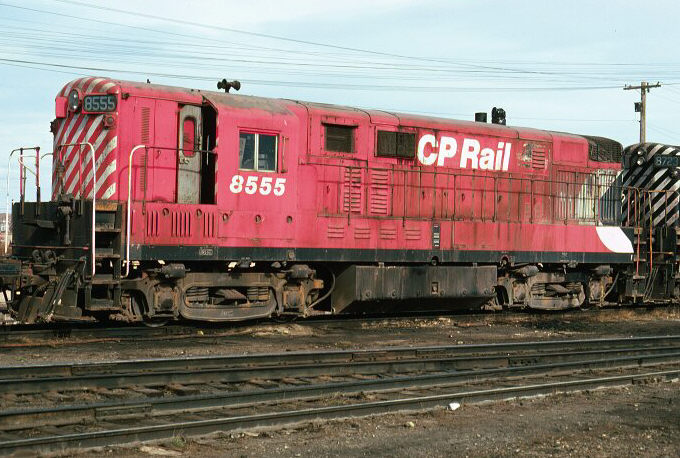- FM H-16-44
Infobox Locomotive
name=FM H-16-44
powertype=Diesel-electric
gauge=RailGauge|sg

caption=Canadian Pacific Railway #8555, an FM H-16-44 road switcher, passes throughCalgary, Alberta in April, 1975. The unit's simplified carbody, rectangular cab side windows, and "C-liner" trucks identifies it as having been built sometime after March of 1955.
builder=Fairbanks-Morse
aarwheels=B-B
cylindercount=8 (Opposed piston )
primemover=FM 38D-8
builddate=April 1950 – February 1963
totalproduction=299
locale=North America
poweroutput=1,600 hp (1,194 kW)
topspeed=65 mph (105 km/h)
weight=250,000 lb (113,000 kg)
tractiveeffort=42,125 lbf (187 kN)
length=51 ft 0 in (15.55 m)
enginetype=2-stroke diesel
aspiration=Roots blower
cylindersize=8.125 in × 10 in
(206 mm × 254 mm)
displacement=4,144 in³ (67.9 L)
transmission=DC generator,
DC traction motors
locobrakes=Straight air
trainbrakes=Air
buildmodel=H-16-44The FM H-16-44 was a
road switcher produced byFairbanks-Morse from April, 1950–February, 1963. The locomotive shared an identical platform and carbody with the predecessor ModelFM H-15-44 (but not the FM H-20-44 end cab road switcher which used a different carbody and frame and a larger prime mover), and were equipped with the same basic H-15-44 ] , an eight-cylinderopposed piston engine that had been rerated to 1,600 horsepower. The H-16-44 was configured in a B-B wheel arrangement, mounted atop a pair of two-axle AAR Type-B road trucks with all axles powered. In late 1950, the Baldwin trucks were almost exclusively replaced with the same units found on the company's "C-liner" locomotives. [Pinkepank, p. FM-333/FM-334]As with many of their F–M contemporaries, the H-16-44s produced through 1954 ( [http://www.rr-fallenflags.org/atsf/atsf3010.jpgATSF #3010] and [http://img45.exs.cx/img45/9475/cnj1517s6ti.jpgCNJR #1517] , for example) featured numerous
Raymond Loewy design touches, in this case largely manifested in the form of sloping body lines and a noticeable protrusion in the long hood around the radiator shutters. Cab side window units include inoperable "half moon"-shaped panes, resulting in an oblong-shaped assembly. To reduce manufacturing costs, the curved window panes were eliminated from later models, and from 1953 onward the raised, elongated headlight mounting was omitted. Units built in the "Spartanized" fashion can be spotted by their straight ends, coupled with the lack of superfluous trim. Ventilation slots were added at the battery box to reduce the possibility of explosions. The final production phase, which commenced in March of 1955, turned out units that most closely resembled the Fairbanks–Morse "Train Master " series.209 were built for American railroads, 58 were manufactured from March, 1955–June, 1957 by the
Canadian Locomotive Company for use inCanada , and 32 units were exported toMexico . Only three intact examples of the H-16-44 are known to survive today; one is the property of a Canadian railroad historical society, while the others are owned byChihuahua al Pacífico and displayed in front of two of their depots in Mexico (at least one has also been put to use by the motion picture industry, and was seen dressed out as [http://www.trainweb.org/chris/B4.jpg"SCOP #101"] in the town ofNuevo Casa Grande in May, 1988).Units produced by Fairbanks-Morse (1950–1963)
Units produced by the Canadian Locomotive Company (1955–1957)
Notes
References
*
*Further reading
*
ee also
*
List of Fairbanks-Morse locomotives External links
* [http://www.thedieselshop.us/FM_H1644.HTML Fairbanks-Morse H16-44 Roster]
* [http://www.thedieselshop.us/PRSVDfm.HTML#Four Preserved Fairbanks Morse Four-Axle Road Switchers]
* [http://members.shaw.ca/cprclc/ Canadian Pacific Railway CLC Locomotives]
Wikimedia Foundation. 2010.
